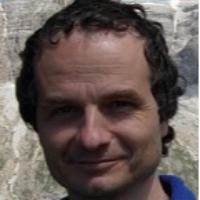Preprint
Article
Symmetry and the Nanoscale: Advances in Analytical Modeling in the Perspective of Holistic Unification
This version is not peer-reviewed.
Submitted:
21 July 2023
Posted:
25 July 2023
You are already at the latest version
A peer-reviewed article of this preprint also exists.
Abstract
Analytical modeling has symmetries and aesthetic-mathematical characteristics that distinguish it from numerical computation. Nanoscience plays an extremely important role in unification efforts that also include holistic aspects of reality. In this paper I present new discovered results about the complete analytical quantum relativistic form of the mean square deviation of position false related to a lately appeared Drude-Lorentz-like model (DS model), already performed at classical, quantum and relativistic level. The function false gives precise information about the distance crossed by carriers (electrons, ions, etc.) inside a nanostructure, considering both quantum effects and relativistic velocities. The model has a wide scale range of applicability; the nanoscale is considered in this paper, but it holds from sub-pico-level to macro-level because of the existence of a gauge factor, making it applicable to every oscillating processes in Nature. Examples of application and suggestions supplement the paper, as well as interesting developments to be studied related to the model and to one of the basic elements of a current unified holistic approach based on the vacuum energy.
Keywords:
Symmetry
; Nanoscale
; Mean Square Deviation of Position
; Quantum-Relativistic Effects
; Analytical Modeling
; Unification
; Holism
; Vacuum Energy.
1. Introduction
The reflection on many contemporary theories dealing with techno-science has underlined how the scientific theory normally precedes subjective and social conditions; the techno-scientific theory does not tend to deal with reality in a global way, but only with the relationship between man and reality, considering the concept of reality as limited by a scientific-phenomenological and non-holistic anthropocentrism.
A holistic view of reality is such if it goes beyond the study and imitation of some characteristics of a particular organism, involving the incorporation of the general characteristics of life in its design and the application of these characteristics on multiple spatial, temporal and organizational scales of global influence.
Science and technology continue to advance, tending towards a complete understanding of the structure and behavior of matter; the nanoscale plays an important role in this evolution, through the study of complex systems (multiscale space-time structures) up to the most complex system, the human brain [1].
In the first decades of the twenty-first century, a concentrated effort is bringing together nanotechnology, biotechnology, information technology and new technologies based on cognitive science. With proper attention to ethical issues and societal needs, the result can be a huge improvement in human capabilities, new products, social outcomes and improved quality of life.
The correlation between different scales is one of the focal points of complexity science, where the correlation between scales is established by analyzing the compromise among the dominant mechanisms [2,3,4]. Multiscale analytical methods present mathematical characteristics and properties not visible in numerical approaches, and are interesting approaches to complex systems linking reductionism and holism.
Nanomaterials are extremely interesting as they provide the building blocks for the construction of nanobiomaterials, which can be both biocompatible and non-toxic. This trend has emerged in nanomedicine and is commonly associated with engineered nanoparticles in the context of bioimaging, drug delivery systems, diagnostic tools and therapeutic modalities [5].
A fruitful combination concerns nanomaterials with biophotonics, i.e. nanobiophotonics; the aspects of electromagnetic nature are related to quantum reality and to approaches of holistic nature, therefore the question concerns how complete is our global understanding of reality without the need of a holistic view of science [6].
The accurate control and handling of individual atoms have recently made possible the production of artificial structures of nanometer size, with new high interesting properties. These nanostructures represent the frontier of progress in materials innovative technology.
It is of primary significance to obtain small objects, but also to have the possibility of checking the nanometric dimensions with careful construction processes, in order to reveal special and peculiar properties.
Physical low-dimensional systems (one or two dimensions) attracted significant attention in recent years, both for the great number of experimental realizations (thanks to the use of nanotechnology and to techniques of laser light), and for the available theoretical techniques. To this class belong the mesoscopic systems, materials with strong electronic correlations and systems of atoms confined in optical lattices.
The reduction of at least one of the dimensions of physical systems to dimensionality of order or less than micron () raised the fame of mesoscopic physics, in which microscopic quantum effects and macroscopic ones play an equal role. The great interest in this field is due to the recent experimental accessibility to sub-micro-dimensions, that brought to the birth of nanotechnology and nanoelectronics [7].
About electronics at mesoscopic scale, a new captivating class of phenomena has been brought to the forefront by the use of quantum physics as the electron spins for the information transport (spintronics) and the realization of macroscopic quantum states, opening interesting prospects in the technology of quantum computation.
About materials with strong electronic correlations, the concourse of different interactions and of different microscopic degrees of freedom originates interesting complex macroscopic behaviors [8].
The deep understanding of the conduct of these systems represents a challenge for fundamental physics, which has a huge technological potential and has already produced significant results. The research activity in this area will improve our understanding of the basic mechanisms underlying the specified materials and systems, suggesting new features, which lead to the creation of “new concept devices” and suggest the importance of the study of new materials.
It is therefore pivotal the theoretical study and mathematical modeling, searching to create new models which integrate the characteristics of the two pillars of modern physics, namely quantum mechanics and relativity. This paper deals with the quantum-relativistic extension of a model which describes analytically the charge transport, appeared in literature in the classical, quantum and relativistic versions [9,10,11]. In detail, the study of the mean square deviation of position will be done.
2. A recently appeared Drude-Lorentz-type Model
A recent theoretical analytical formulation is showing to fit very well with observed scientific data and also provides stimulating new predictions of several characteristics in nanostructures. It contains a gauge factor which allows its use for the study of dynamics processes from sub-pico-level to macro-level.
The model is based on the total Fourier transform of the frequency-dependent complex conductivity , which can be inferred by the linear response theory [12,13,14,15,16].
The presence of a (0, +∞) integration in the Green-Kubo formula is an obstacle for the analytical inversion, but in this model it is overcome by evaluation of the integral on the whole time axis (-∞, +∞), considering the real part of the complex conductivity. The new introduced key idea is the integration on the entire time axis (-∞, +∞), not on the half time axis (0, +∞), as ordinarily considered in literature [17].
The model expands the Drude-Lorentz relation entailing the complex conductivity and rests on the reversal of the total Fourier transform in the complex plane considering the whole time axis:
The mean square deviation of position of particles at equilibrium is defined as:
where is the position vector at the time t. Considering that it holds:
where is the velocity, and considering that for a homogeneous system in equilibrium the invariance property for time translation holds, it is possible to rewrite Equation (2) considering a transformation of coordinates relative to the region of integration. We get:
can then be evaluated using the velocities correlation function.
3. Analytical Expression of the Mean Square Deviation of Position in the Quantum-Relativistic Case
a) About the quantum behaviour, I considered the consequence of a frequency-dependent electric field of the form ; going after the time-dependent perturbation theory, I considered the factor as perturbing potential (in this context is the position vector of the particle).
The matrix elements of the dipole moment of the charge in the direction of the electric field, between the initial and the excited states, are given by:
Defining the oscillator strength of the j-th transition as:
and keeping into account of the relation between permittivity and conductivity of the system:
we obtain the relation:
with:
In previous equations it is:
- -
- ;
- -
- , energies of the excited and the ground states respectively;
- -
- inverse of the decay time of every mode;
- -
- N density of carriers.
As in the classical case, the analytical calculation formally brings to Equation (1), but with the fundamental difference that the real part of conductivity inside the integral is calculated at quantum level. The key factors including the quantum behaviour are the weights . The relaxation times can be obtained by and weights (Equation (9)). The calculation of N can be exactly obtained by Equation (9), considering that it holds: [1].
b) About the relativistic behaviour, starting by the dynamics law:
I studied the relativistic variation of the mass along an x-axis in the fixed ground reference frame. Regarding the forces acting on the generic carrier, I considered an outer passive elastic-type force of the type , a passive friction-type force of the type , depending by the velocity and with , and an outer oscillating electric field , considering solutions of the type . The analytical calculation brings to three sets of results, in relation to the value of the quantity , as in the classical and quantum case [7].
The expressions of in the quantum (Q) and relativistic (R) cases are respectively [18]:
(Q) Quantum case:
Q1) Case
with:
(positive real numbers);
Q2) Case
with:
.
m0 is the rest mass, m* the effective mass, K the Boltzmann’s constant, T the system’s temperature, and frequencies and decaying times of each mode.
(R) Relativistic case:
R1) Case
with:
(positive real numbers);
R2) Case
with:
.
It holds: , , , , .
With the procedure used for obtaining the expressions of the velocities correlation function in the quantum-relativistic case [18], the new results for the mean square deviation of position have the following analytical form:
(Q-R) Quantum-Relativistic case:
Q-R1) Case
with:
(positive real numbers);
Q-R2) Case
with:
.
It holds: , , , , .
4. Results, Discussion and Examples of Application
The achieved results in the classical case explain the extreme short times and elevated mobilities, with which charges diffuse in mesoporous systems, of broad interest in all systems involving photocatalysis and photovoltaics. The small times of few show facile charge diffusion inside the nanoparticles. The undescribed experimental fact of ultrashort injection of charge carriers, particularly in Grätzel’s cells, can be referred to this phenomenon. Deviations by the Drude model become powerful in nanostructured materials, such as photoexcited TiO2 nanoparticles, ZnO films, InP nanoparticles, semiconducting polymer molecules and carbon NTs [19,20,21,22].
The quantum and relativistic models provided newsworthy additional features and added novel ones. The quantum model considers the weight of varied modes with the own and values, the relativistic model meets extreme high velocities of carriers inside nanostructures. The quantum-relativistic case connects both characters.
As examples of application, Figure 1 illustrates the evolution of vs time for the fixed value () in the case of one only mode (not quantum behaviour) for ZnO (; ) [20]; I considered as velocities of carriers (blue solid line), (red dashed line) and (green dot-dashed line) (Table 1). From Equation (20) it follows: .
In Figure 2, I considered the case with in relation to one only mode (not quantum behaviour); from Equation (22) it follows: [20].
Then I considered experimental data by literature, from which three states were extracted; Table 2 summarizes the calculated used values. Data are related to single-walled carbon nanotube films at the temperature of 300 K [23,24,25].
Thanks to Equations (20) and (22), the values of for the three states result: ; ; . These values must be calculated for each considered velocity.
Figure 6 reproduces what we obtain considering the global state as sum of the previous three states.
In Figure 7 we see the general quantum-relativistic case, i.e. considering the quantum behaviour related to the presence of more than one state and the variation of velocity (increasing in our case).
From these examples we conclude that it is possible to perform a careful and general quantum-relativistic study of the carrier transport in nanostructures.
The assumption of relativistic speeds and quantum features inside a nanostructure is an attractive present topic; quantum processes with extreme high speeds of carriers are pertinent for current science and technology and are elected by a key point for the future in theoretical and phenomenological (nano)physics.
What debated here can be thought like the starting point of a research pathway referred to physical suppositions, namely how scattering, ballistic transport, influence of temperature [24], size effect, etc., can impact on the studied phenomenon. A challenge arises for phenomenological scientists whose insight could fruitfully match these theoretical efforts.
About the present phenomenological investigation, two ways are suggested:
1) Photon-Induced Near-Field Electron Microscopy: this inspection technique connects the spatial resolution at the nanoscale of the electron microscopy with the femto-second temporal resolution of extreme fast light impulses; it can be used to check very fast occurrences present at very small length scales. A way for raising the electron-light interactions in very short intervals consists in enlarging the light field through two synchronized femto-second light impulses. Variations of the time delay among the exciting light impulses and the electronic imaging ones allow to obtain snapshots of the evanescent field whereas it evolves on femto-second intervals. The application of still shorter pulses can allow to keep trace of the extreme fast processes happening in photonic and plasmonic devices [26,27].
2) Graphene based Plasmonics: the not linear optical properties of a plasma expected in the relativistic movement of electrons subjected to a high laser field are of central significance for present research. Recently there was a fast progress in the sector of graphene plasmonics, considering the graphene’s special global properties. The application of graphene plasmonics will give stimulating results in the little exploited terahertz to mid-infrared regime.
Graphene and plasmonics strongly overlap, both for the inherent plasmons of graphene and for its mixture with noble metal nanostructures. Graphene based plasmonics can allow the creation of novel optical devices that work in various frequency ranges, from terahertz to visible light, associated to ultra-high speed [28,29,30,31].
5. Conclusions
In this paper I introduced new formulas relating to a quantum-relativistic model for the study of transport dynamics at the nanoscale. The obtained results allow the accurate study of transport dynamics contemplating quantum and relativistic effects. In particular, the quantum-relativistic formulas for the function have been introduced.
At phenomenological level, the extreme fast carrier injection is suggested, in relation to manageable technical needs related to a raise of the wavelength of oscillations and a reduction of the amplitude of .
The quantum-relativistic version of the model is mathematically very elegant, because of its analytical formulation, and provides an attractive novelty, which can be fruitfully object of experimental investigation through time-resolved techniques, like TRTS, PINEM, Graphene based Plasmonics [32,33,34].
Keeping into account all parameters which can influence the system at chemical, physical, structural level, so as the intrinsic in the model ones, like the system’s temperature T, the values of , , and , possible variations of the effective mass , changes of the chiral vector, the quantum weights of modes, the carrier density N, the speed of carriers, it is possible to carry out a careful tuning of , , and .
From quantum physics we know that everything is energy, vibration, and this is connected with the energy of the vacuum. The attempts to define the structure and the global intrinsic properties of the space constitute a rigorous modern line of research.
In this direction, interesting results were obtained in relation to the ontological interpretation of quantum theory [35,36,37], with the Fourier transform playing a very important role; this last is one of the core elements of the described analytical model of transport dynamics at the nanometric level, which has a gauge factor allowing its use in a wider range than nanoscale only [38].
Other related concepts connected to this project concern how particular symmetries of are reflected on the solutions of the model, the possible involvement of advanced and delayed waves, the “intrinsic quantum ergonomics”, the concept of “extended self”.
Funding
This research received no external funding.
Acknowledgments
The author wishes to thank Ms. Teresa Yu, Chief-Section Managing Editor, and all those who supported the success of this interesting Special Issue.
Conflicts of Interest
The author declares no conflict of interest.
References
- Di Sia, P. Industry 4.0 Revolution: Introduction. In Handbook of Smart Materials, Technologies, and Devices; Hussain, C.M., Di Sia, P., Eds.; Springer Nature: Cham, Switzerland, 2021; Chapter 1; pp. 1–20. [Google Scholar] [CrossRef]
- Ge, W.; Chen, F.; Gao, J.; Gao, S.; Huang, J.; Liu, X.; Ren, Y.; Sun, Q.; Wang, L.; Wang, W.; Yang, N.; Zhang, J.; Zhao, H.; Zhou, G.; Li, J. Analytical multi-scale method for multi-phase complex systems in process engineering - Bridging reductionism and holism. Chemical Engineering Science 2007, 62, 3346–3377. [Google Scholar] [CrossRef]
- Ellis, G.F.R.; Di Sia, P. Approaches to Complexity and Emergence: Broken Symmetries and Holistic Unification. Symmetry (MDPI) 2023, submitted.
- Ellis, G.F.R. Emergence in Solid State Physics and Biology. Foundations of Physics 2020, 50, 1098–1139. [Google Scholar] [CrossRef]
- Di Sia, P. On risks and benefits of nanotechnology: the case of medical applications. In Handbook of Functionalized Nanomaterials: Environmental Health and Safety; Hussain, C.M., Kumar, V., Eds.; Elsevier Publishing: Amsterdam, the Netherlands, 2021; Chapter 9; pp. 235–250. [Google Scholar]
- Healey, R. Holism in Quantum Mechanics. In Compendium of Quantum Physics; Greenberger, D., Hentschel, K., Weinert, F., Eds.; Springer: Berlin, Heidelberg, Germany, 2009. [Google Scholar]
- Di Sia, P. Mathematics and Physics for Nanotechnology - Technical Tools and Modelling; Di Sia, P., Ed.; Pan Stanford Publishing: Singapore, 2019. [Google Scholar]
- Di Sia, P. Modelling at Nanoscale. In Plasmonics - Principles and Applications; Kim, K.Y., Ed.; IntechOpen: London, UK, 2012; Chapter 1; pp. 3–22. [Google Scholar] [CrossRef]
- Di Sia, P. An Analytical Transport Model for Nanomaterials, Journal of Computational and Theoretical Nanoscience 2011, 8, 84–89. [CrossRef]
- Di Sia, P. An Analytical Transport Model for Nanomaterials: The Quantum Version, Journal of Computational and Theoretical Nanoscience 2012, 9, 31–34. [CrossRef]
- Di Sia, P. Relativistic nano-transport and artificial neural networks: details by a new analytical model. International Journal of Artificial Intelligence and Mechatronics 2014, 3, 96–100, ttps://www.ijaim.org/vol-issues.html?view=publication&task=show&id=95. [Google Scholar]
- Beard, M.C.; Turner, G.M.; Schmuttenmaer, C.A. Terahertz spectroscopy, Journal of Physical Chemistry B 2002, 106, 7146–7159. [CrossRef]
- Th Hassan, M. Attomicroscopy: from femtosecond to attosecond electron microscopy, Journal of Physics B: Atomic, Molecular and Optical Physics 2018, 51, 032005. [CrossRef]
- Di Sia, P. A new theoretical Model for the dynamical Analysis of Nano-Bio-Structures, Advances in Nano Research 2013, 1, 29–34. [CrossRef]
- Di Sia, P.; Dallacasa, V. Anomalous charge transport: a new “time domain” generalization of the Drude model, Plasmonics 2011, 6, 99–104. [CrossRef]
- Rudin, W. Real and Complex Analysis, 3rd ed.; McGraw-Hill Higher Education: Singapore, 1987. [Google Scholar]
- Ventura, P.J.; Costa, L.C.; Carmo, M.C.; Roman, H.E.; Pavesi, L. AC Conductivity of Porous Silicon from Monte Carlo Simulations, Journal of Porous Materials 2000, 7, 107–110. [CrossRef]
- Di Sia, P. Quantum-Relativistic Velocities in Nano-Transport, Applied Surface Science 2018, 446, 187–190. [CrossRef]
- Schmuttenmaer, C.A. Using Terahertz Spectroscopy to Study Nanomaterials, Terahertz Science and Technology 2008, 1, 1–8. 1. [CrossRef]
- Baxter, J.B.; Schmuttenmaer, C.A. Conductivity of ZnO Nanowires, Nanoparticles, and Thin Films Using Time-Resolved Terahertz Spectroscopy, Journal of Physical Chemistry B 2006, 110, 25229–25239. [CrossRef]
- Baxter, J.B.; Schmuttenmaer, C.A. Carrier Dynamics in Bulk ZnO. I. Intrinsic Conductivity Measured by Terahertz Time Domain Spectroscopy, Physical Review B 2009, 80, 235206–1. [Google Scholar] [CrossRef]
- Terahertz Spectroscopy - Principles and Applications, 1st ed. ; Dexheimer, S.L., Ed.; CRC Press Taylor & Francis Group LLC: Boca Raton, USA, 2008. [Google Scholar]
- El Shabrawy, K.; Maharatna, K.; Bagnall, D.; Al-Hashimi, B.M. Modeling SWCNT Bandgap and Effective Mass Variation Using a Monte Carlo Approach, IEEE Transactions on Nanotechnology 2010, 9, 184–193. [CrossRef]
- Di Sia, P. About the Influence of Temperature in Single-Walled Carbon Nanotubes: Details from a new Drude-Lorentz-like Model, Applied Surface Science 2013, 275, 384–388. [CrossRef]
- Borondics, F.; Kamarás, K.; Nikolou, M.; Tanner, D.B.; Chen, Z.H.; Rinzler, A.G. Charge dynamics in transparent single-walled carbon nanotube films from optical transmission measurements, Physical Review B 2006, 74, 045431–045436. [CrossRef]
- Park, S.T.; Lin, M.; Zewail, A.H. Photon-induced near-field electron microscopy (PINEM): theoretical and experimental, New Journal of Physics 2010, 12, 123028. [CrossRef]
- Park, S.T.; Zewail, A.H. Relativistic Effects in Photon-Induced Near Field Electron Microscopy, Journal of Physical Chemistry A 2012, 116, 11128–11133. [CrossRef]
- Grigorenko, A.N.; Polini, M.; Novoselov, K.S. Graphene plasmonics, Nature Photonics 2012, 6, 749–758. [CrossRef]
- Koppens, F.H.L.; Chang, D.E.; García de Abajo, F.J. Graphene Plasmonics: A Platform for Strong Light-Matter Interactions, Nano Letters 2011, 11, 3370–3377. [CrossRef]
- Huang, S.; Song, C.; Zhang, G.; Yan, H. Graphene plasmonics: Physics and potential applications, Nanophotonics 2017, 6, 1191–1204. [CrossRef]
- Kuzmin, D.A.; Bychkov, I.V.; Shavrov, V.G.; Temnov, V.V. Plasmonics of magnetic and topological graphene-based nanostructures. arXiv:1711.10777v1. [CrossRef]
- Kovalev, S.; Green, B.; Golz, T.; Maehrlein, S.; Stojanovic, N.; Fisher, A.S.; Kampfrath, T.; Gensch, M. Probing ultra-fast processes with high dynamic range at 4th-generation light sources: Arrival time and intensity binning at unprecedented repetition rates, Structural Dynamics 2017, 4, 024301–(1–7). [CrossRef]
- Bennett, K.; Rouxel, J.R.; Mukamel, S. Linear and nonlinear frequency- and time-domain spectroscopy with multiple frequency combs, Journal of Chemical Physics 2017, 147, 094304. [CrossRef]
- Hafez, H.A.; Chai, X.; Sekine, Y.; Takamura, M.; Oguri, K.; Al-Naib, I.; Dignam, M.M.; Hibino, H.; Ozaki, T. Effects of environmental conditions on the ultrafast carrier dynamics in graphene revealed by terahertz spectroscopy, Physical Review B 2017, 95, 165428. [CrossRef]
- Bohm, D. Wholeness and the Implicate Order, 1st ed.; Routledge: London (UK) and New York (USA), 2002. [Google Scholar]
- Bohm, D.; Hiley, B.J. The Undivided Universe: An Ontological Interpretation of Quantum Theory, 1st ed.; Routledge: London (UK) and New York (USA), 1995. [Google Scholar]
- Pribram, K.H. Languages of the Brain: Experimental Paradoxes and Principles in Neuropsychology, 5th ed.; Brandon House: New York(USA), 1971. [Google Scholar]
- Di Sia, P. The Primordial Dynamic Space (Introduction 1). OSF Preprint services 2022. https://osf.io/qd4fb/.
Figure 1.
R2(t) vs t with aRQ−R = 10, T = 300 K; V = 107 cm/s (blue solid line), V = 1010 cm/s (red dashed line) and v = 2.5 · 1010 cm/s (green dot-dashed line).
Figure 1.
R2(t) vs t with aRQ−R = 10, T = 300 K; V = 107 cm/s (blue solid line), V = 1010 cm/s (red dashed line) and v = 2.5 · 1010 cm/s (green dot-dashed line).
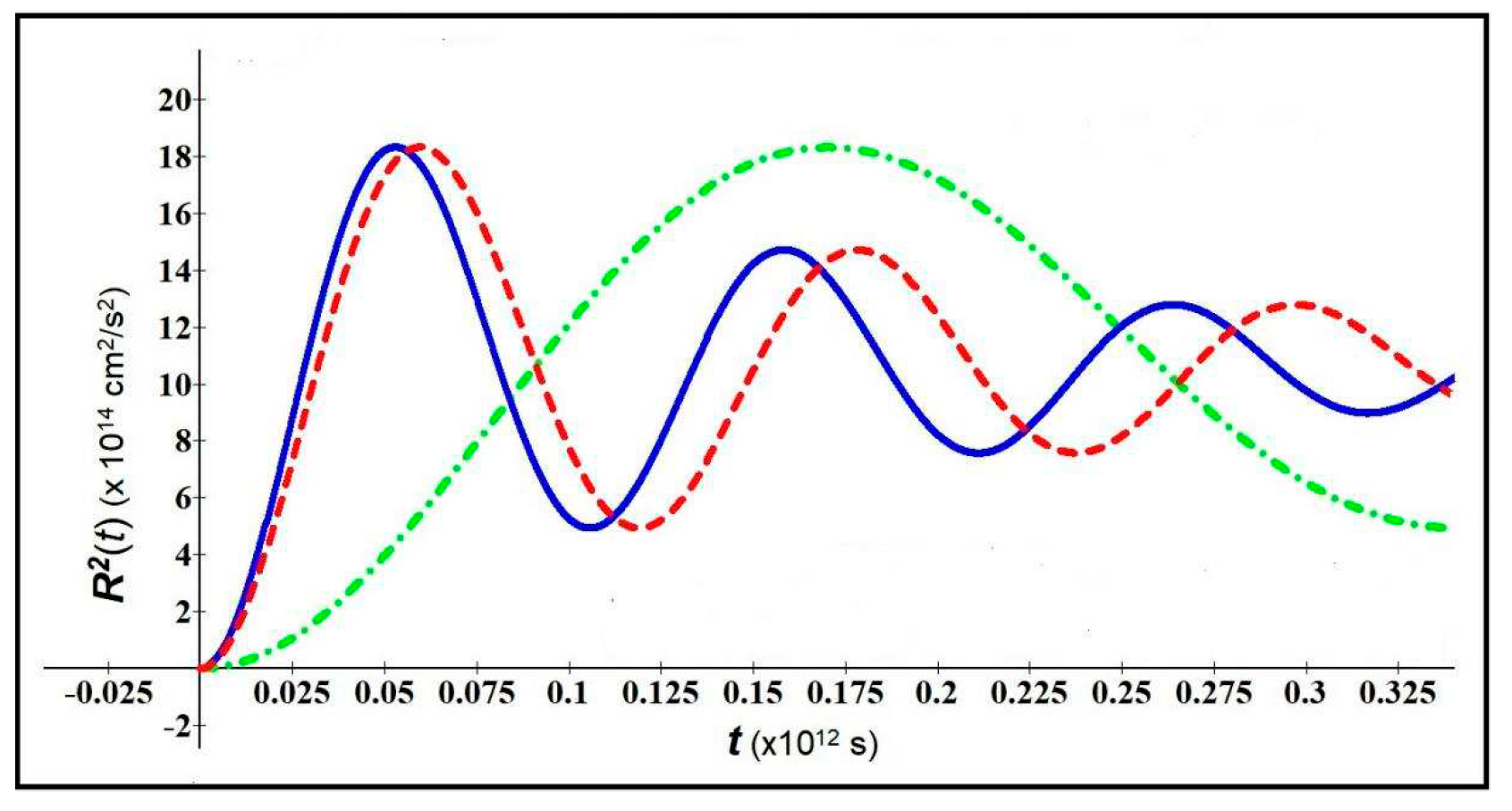
Figure 2.
R2(t) vs t with aIQ−R = 10, T = 300 K; v = 107 cm/s (blue solid line), v = 1010 cm/s (red dashed line) and v = 2.5 · 1010 cm/s (green dot-dashed line).
Figure 2.
R2(t) vs t with aIQ−R = 10, T = 300 K; v = 107 cm/s (blue solid line), v = 1010 cm/s (red dashed line) and v = 2.5 · 1010 cm/s (green dot-dashed line).
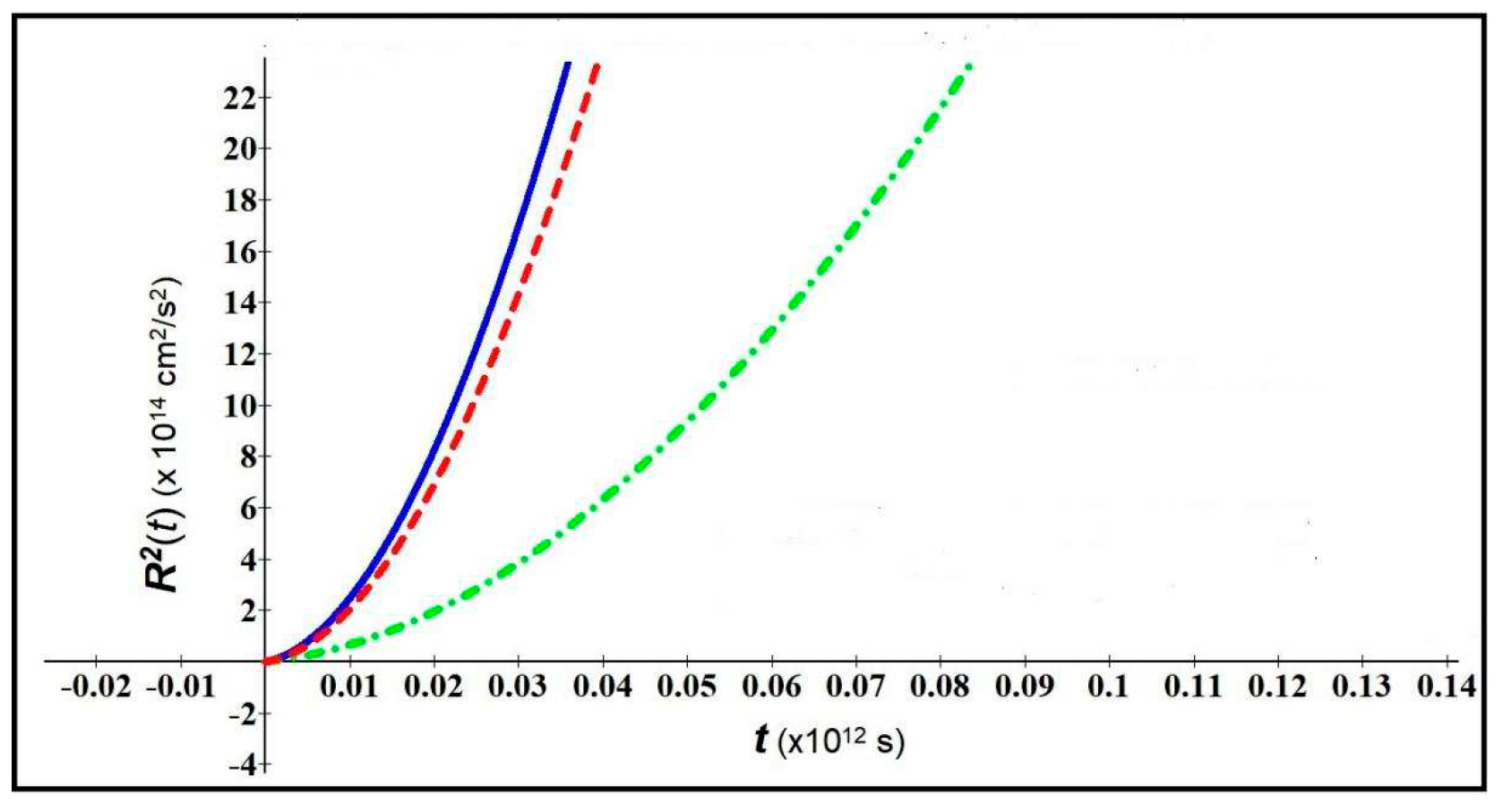
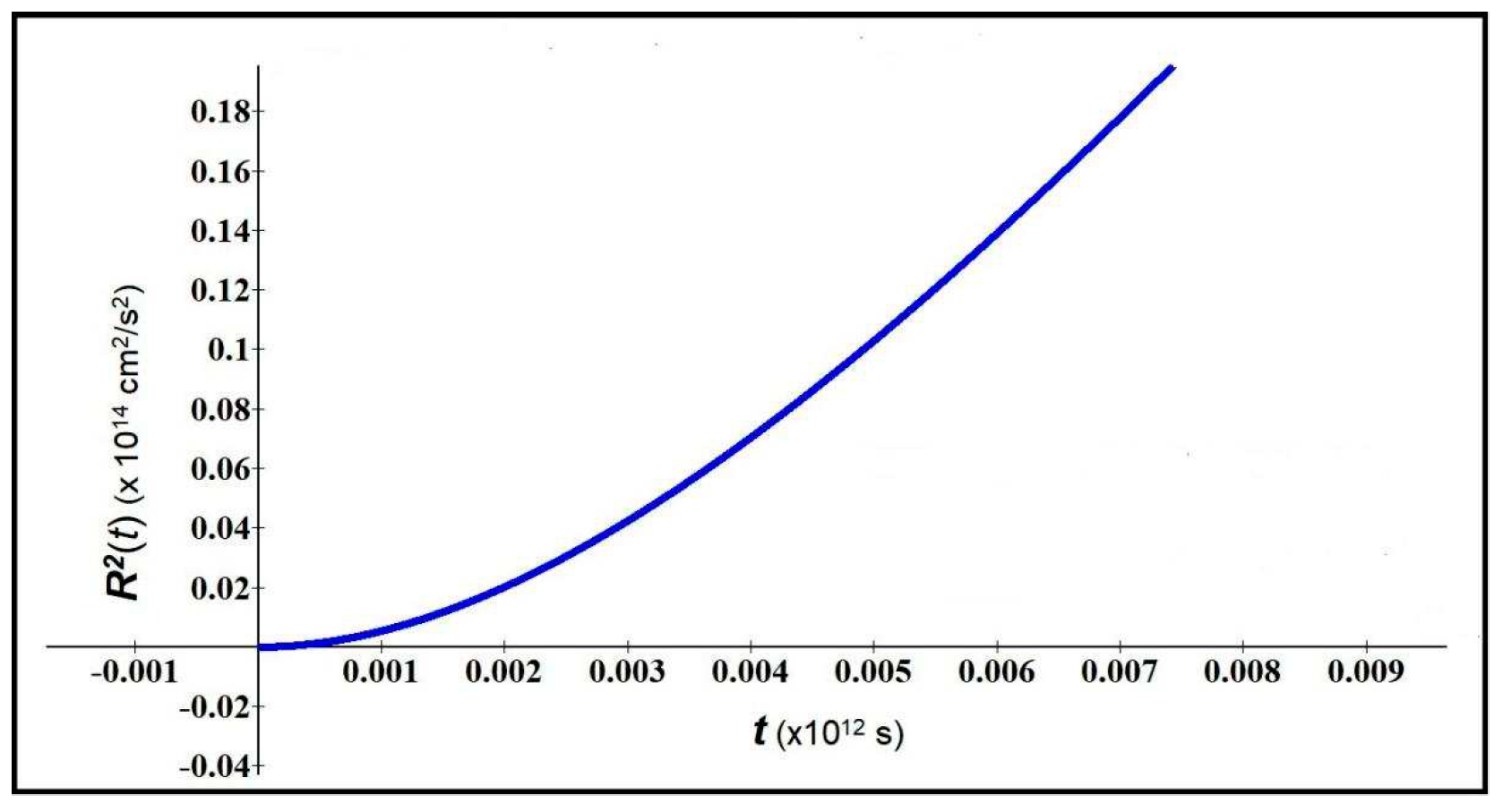
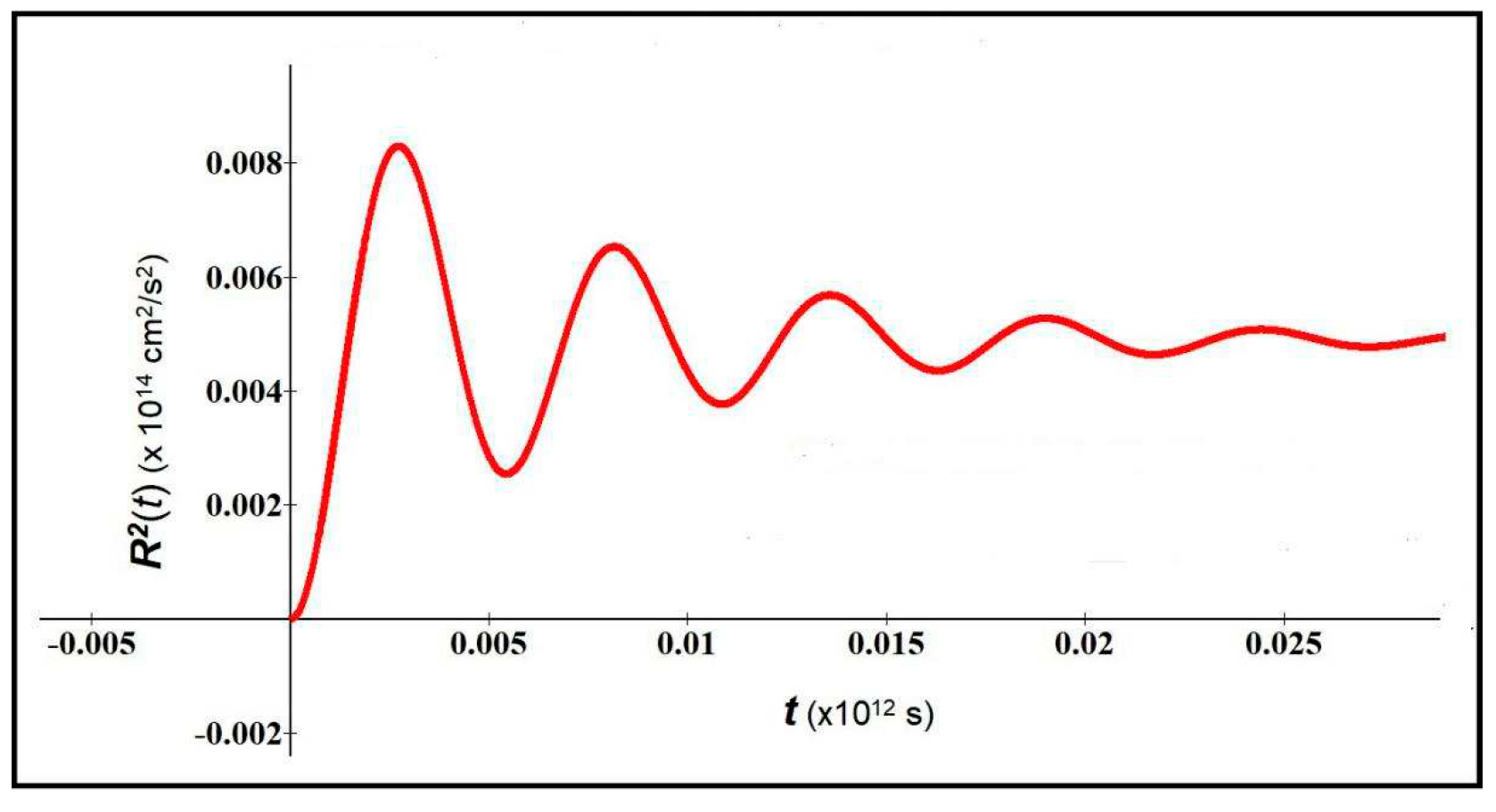
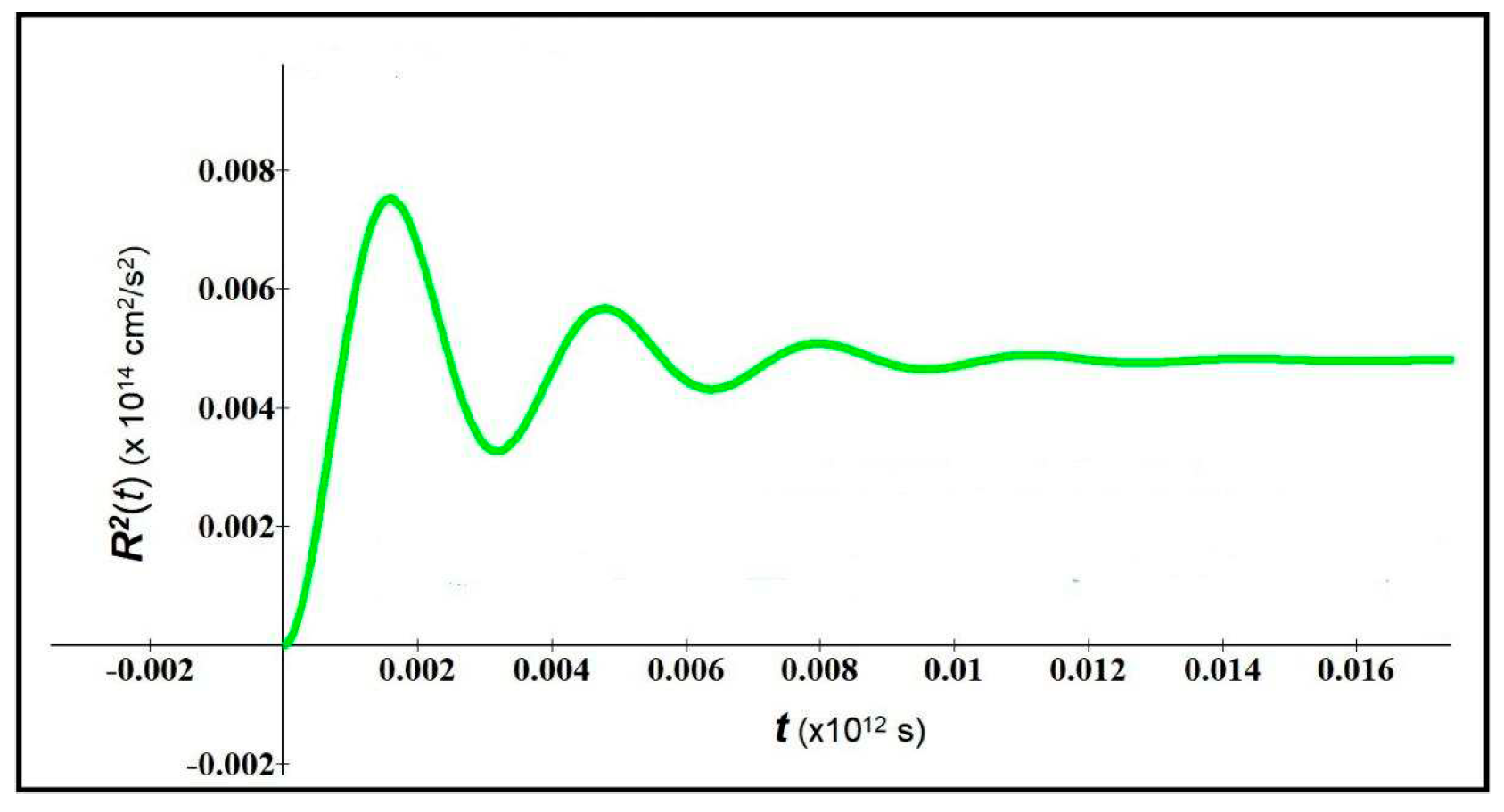
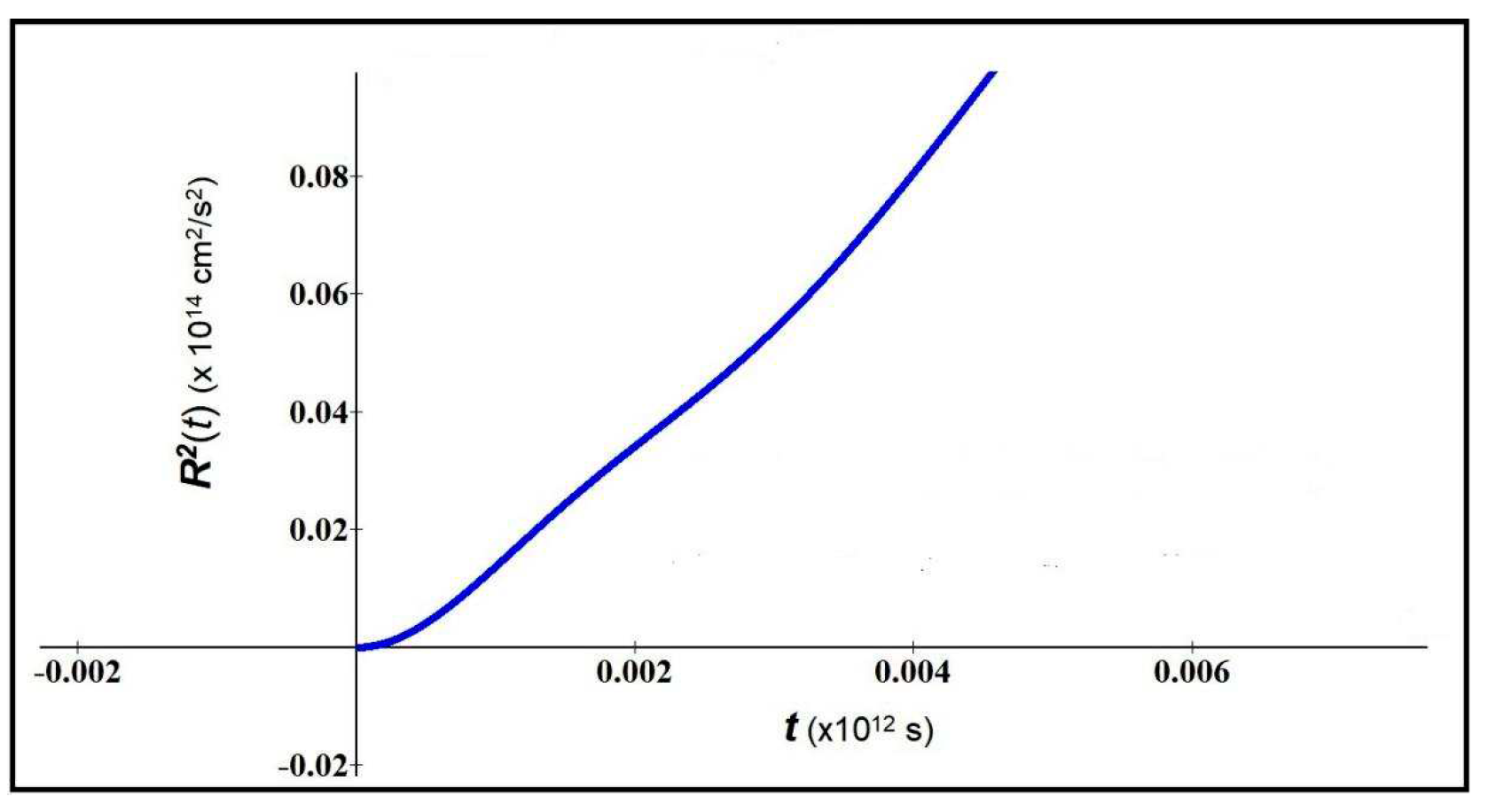
Figure 7.
R2(t) vs t for a state given by the sum of the previous three states (data from Table 2), considering three different velocities (v = 107 cm/s (blue solid line), v = 1010 cm/s (red dashed line) and v = 2.5 · 1010 cm/s (green dot-dashed line)).
Figure 7.
R2(t) vs t for a state given by the sum of the previous three states (data from Table 2), considering three different velocities (v = 107 cm/s (blue solid line), v = 1010 cm/s (red dashed line) and v = 2.5 · 1010 cm/s (green dot-dashed line)).
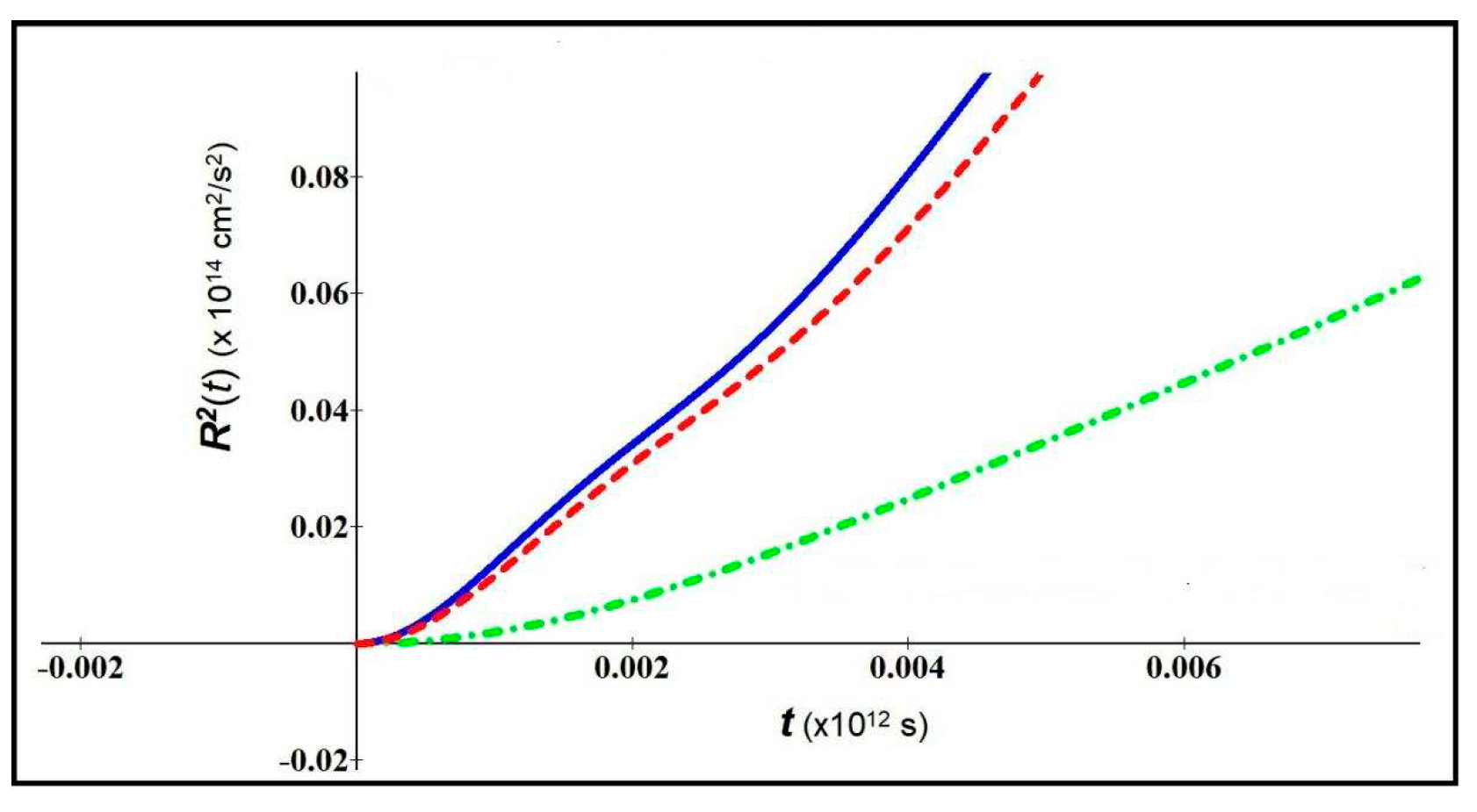
Table 1.
Computed data for the three examined velocities of carriers.
| v (cm/s) | β2 | 1/ρ | γ |
|---|---|---|---|
| 107 | 0.11 . 10-6 | 0.998 | 1.001 |
| 1010 | 0.11 | 0.888 | 1.061 |
| 2.5 . 1010 | 0.69 | 0.31 | 1.796 |
Table 2.
Values of each examined state.
| States | ωi (x 10 -12 Hz) | τi (x 10 12 Hz) | fi |
|---|---|---|---|
| 1 | 6.59 | 0.0042 | 0.312 |
| 2 | 1166.01 | 0.0037 | 0.176 |
| 3 | 2000.05 | 0.0014 | 0.512 |
Disclaimer/Publisher’s Note: The statements, opinions and data contained in all publications are solely those of the individual author(s) and contributor(s) and not of MDPI and/or the editor(s). MDPI and/or the editor(s) disclaim responsibility for any injury to people or property resulting from any ideas, methods, instructions or products referred to in the content. |
© 2023 by the author. Licensee MDPI, Basel, Switzerland. This article is an open access article distributed under the terms and conditions of the Creative Commons Attribution (CC BY) license (https://creativecommons.org/licenses/by/4.0/).
Copyright: This open access article is published under a Creative Commons CC BY 4.0 license, which permit the free download, distribution, and reuse, provided that the author and preprint are cited in any reuse.
Downloads
87
Views
32
Comments
0
Subscription
Notify me about updates to this article or when a peer-reviewed version is published.
MDPI Initiatives
Important Links
© 2025 MDPI (Basel, Switzerland) unless otherwise stated

